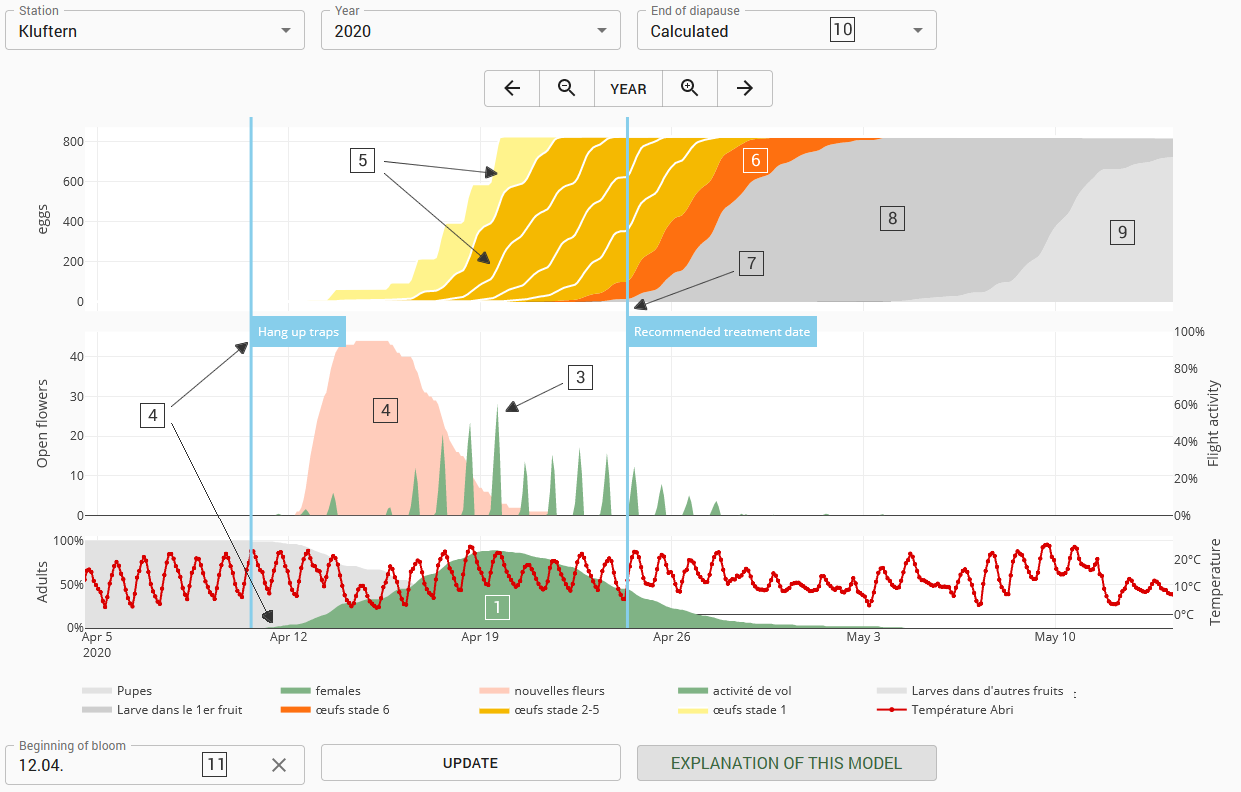fruitweb forecast model Apple Sawfly
The fruitweb forecast model for the apple sawfly is a complex model for simulating the population development of this important insect pest in apple cultivation. The following statements can be made with the model:
- When is the hatching and the start of flight of the adults to be expected and what is the course of the flight [1]. On the basis of this information, the optimal date for hanging up the white boards can be found [2].
- Simulation of daily flight activity and oviposition [3] by the adult females. Since the eggs are only laid in the base of freshly opened flowers, the flowering process is simulated [4]. IMPORTANT: The model can only deliver good results if the start of flowering of the respective variety is specified exactly.
- Development of the different egg stages [5] up to the last egg stage („black-eye stage“) [6]. Determination of the best spray date for larvicidal preparations (e.g. Quassia) when 2% of the larvae have hatched [7].
End of the diapause
The apple sawfly overwinters in a prepupal stage in the ground. At this stage, also called diapause, there is no development. About 3 to 4 weeks before the adult animals hatch, the diapause ends and the animals develop from the pupa into winged animals. For the calculation of the hatching date of the adults, the end of the diapause must be determined. There are three setting options for this [10]:
- Fixed date March 15th: Graf et. al. (1996) found that when the end of the diapause is set for March 15 and the calculation based on the soil temperature, a good forecast of the hatching date can be made. Since there are hardly any weather stations with soil temperature sensors in orchards, Trapman (2016) applied the same method with adapted parameters to the air temperature and also achieved acceptable results. However, it has been shown that in years with very early flowering this process does not work (e.g. 2020).
- Calculation of the end of the diapause: due to the weaknesses of the above procedure, fruitweb GmbH has developed a modified procedure. Instead of a fixed date, the end of the diapause is calculated using a temperature sum. Initial studies have shown that this method allows the hatching of the adult animals to be predicted much better. The procedure also produced very good results in the extremely early year 2020.
- 100% adults: This setting option does not determine the end of the diapause. Rather, it is determined that the hatching of the adult animals is not simulated, but that the model should assume during flowering that 100% of the animals are always present in the facility. It is thus a security setting.
The end of the diapause and the hatching of the adults are shown in the lower line. Shortly before the start of the flight, the hanging of the whiteboards is indicated by a vertical line [4].
Flight activity of the adult animals
Adult saw wasps only fly at a temperature of around 11° C and only during the day. Their flight activity is highest on sunny, windless days [3]. For the simulation of the flight activity and thus also the egg-laying by the females, only the temperature is used at the moment. However, it is planned to take the wind speed and the sunshine intensity into account in the future.
Egg laying and flowering
The adult females lay their eggs exclusively in the base of freshly opened flowers (royal blossoms on perennial fruit wood are preferred). For this reason it is very important to indicate the exact start of flowering [11]. The course of the freshly opened flowers is then displayed in the middle graphic [4]. In the upper graphic, the freshly laid eggs, the ice stages 2 to 5 [5] and the critical „roach“ stage [6] are displayed. It is not the number of open flowers that is responsible for the intensity of the oviposition, but only the intensity of flight activity. It is therefore assumed that as soon as flowers are opened, their absolute number does not limit the oviposition.
Larvae hatch and onset of diapause
Die Larven in der ersten Frucht werden in einem dunklen grau dargestellt [8]. Die Larven in den Folgefrüchten hellgrau [9]. Für diese Stadien gibt es kaum gesicherte Daten, so dass die Darstellung nur eine ungefähre Einschätzung der Situation wiedergibt. Die Abnahme der hellgrauen Fläche stellt schließlich das Vergraben der Larven im Boden und den Eintritt in die Diapause dar.
Forecast of the treatment date
In organic fruit growing, Quassia is treated shortly before the larvae hatch, depending on the approval situation. In the forecast model, this date is determined when 2% of the larvae have hatched. This is indicated by a vertical line [7]. Depending on the weather, the larvae hatch may take longer, so that further treatment may be necessary. However, the model does NOT address this fact.
Literature:
GRAF B.,HÖHN H.,HÖPLI H. U., 1996a.-The apple sawfly, Hoplocampa testudineaKlug (Hymenoptera, Tenthredinidae): a temperature driven model for spring emergence of adults.-Entomologia Experimentalis et Applicata, 78: 301-307.
GRAF B.,HÖPLI H.U.,HÖHN H., 1996b.-Modelling spring emergence of the apple sawfly Hoplocampa testudineaKlug (Hymenoptera, Tenthredinidae).-Acta Horticulturae, 416: 263-271.
GRAF B.,HÖPLI H.U.,HÖHN H.,2001.-The apple sawfly, Hoplocampa testudinea: temperature effects on adult life-span and reproduction.-Entomologia Experimentalis et Ap-plicata, 98: 377-380.
GRAF B.,HÖPLI H.U.,HÖHN H., 2002.-The apple sawfly, Hoplocampa testudinea: egg development and forecasting of egg hatch.-Entomologia Experimentalis et Applicata, 105: 55-60.
TRAPMAN M.C.,2016a.-The development of a dynamic simulation model for the biology of the apple sawfly (Hoplocampa testudinea), and the implementation as decision support system, pp. 60-68.In: Proceedings of the 17thinternational conference on organic fruit-growing, February 15-17, University of Hohenheim, Stuttgart, Germany.

